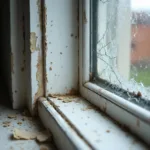Discovering a hole in your cloth car seat can be disheartening, but it’s a common issue that can often be fixed without needing a professional. This guide will take you through the steps on how to repair a hole in your cloth car seat, restoring its appearance and preventing further damage.
Assessing the Damage: Size and Location Matter
Before diving into the repair, it’s crucial to assess the extent of the damage. Small holes or tears are generally easier to fix than larger ones. Additionally, the location of the hole plays a role. A hole on the seat cushion might require a different approach than one on the backrest.
Gathering Your Supplies: The Right Tools for the Job
Having the right tools and materials on hand will make the repair process smoother:
- Matching Fabric Patch: Choose a fabric patch that closely matches the color and texture of your car seat. You can often find remnants or swatches at fabric stores or online.
- Scissors: Sharp fabric scissors will ensure clean cuts for your patch.
- Adhesive Backing (Optional): This helps secure the patch in place. Look for fabric glue or adhesive specifically designed for automotive upholstery.
- Upholstery Needle and Thread: If you’re comfortable with sewing, using a needle and thread can provide a more durable repair.
- Iron and Ironing Board (Optional): Useful for setting adhesive backing or creating clean edges on your fabric patch.
Repairing the Hole: Step-by-Step Guide
The repair method will vary slightly depending on the size of the hole and your chosen approach. Here’s a general guide:
1. Prepare the Area
Clean the area around the hole thoroughly using a vacuum cleaner and a damp cloth to remove any dirt or debris. Allow the area to dry completely before proceeding.
2. Prepare the Patch
If the hole is small, you can skip this step. However, for larger holes:
- Cut a fabric patch slightly larger than the hole, ensuring it covers the damaged area completely.
- If using adhesive backing, follow the manufacturer’s instructions to apply it to the back of your fabric patch.
3. Secure the Patch
- For small holes or using adhesive backing: Carefully align the patch over the hole and press firmly to secure it in place.
- For larger holes or using needle and thread: Thread your upholstery needle with a strong thread that matches your fabric. Carefully stitch around the edges of the hole, securing the patch from the underside of the fabric.
4. Finishing Touches
- For adhesive backing: Allow the adhesive to dry completely according to the manufacturer’s instructions.
- For stitching: Tie off your thread securely and trim any excess.
Tips for a Seamless Repair
- Test Your Adhesive: Always test your adhesive on a hidden area of your car seat fabric first to ensure it doesn’t cause discoloration or damage.
- Consider Professional Help: For larger holes, tears in delicate fabrics, or if you’re uncomfortable with DIY repairs, it’s best to consult a professional upholstery repair service.
- Preventative Measures: Using seat covers or placing a towel on your car seat before transporting pets or heavy objects can help prevent future tears and holes.
Conclusion
Repairing a hole in a cloth car seat is a manageable task that can save you the cost of professional repair or replacement. By following these steps and using the right materials, you can restore your car seat’s appearance and prolong its lifespan. Remember, addressing the issue early can prevent further damage and keep your car’s interior looking its best.
FAQs
1. Can I use duct tape to temporarily fix a hole in my car seat?
While duct tape might seem like a quick fix, it’s not recommended for car seat repairs. The adhesive can leave a sticky residue and may not hold up well to heat and wear and tear.
2. What type of fabric is best for patching car seats?
Look for upholstery fabric that closely matches the material of your car seat. Leatherette, vinyl, or durable cloth fabrics are suitable options.
3. How can I prevent my car seat from getting more holes?
Using seat covers, being mindful of sharp objects, and trimming pet nails regularly can help prevent future damage to your car seats.
4. Can I dye the fabric patch to match my car seat color exactly?
Dyeing fabric can be tricky, and it’s essential to use a dye specifically designed for the fabric type of your patch and car seat. Test the dye on a hidden area first to ensure color accuracy.
5. Is it worth repairing a car seat with a large hole, or should I replace it?
The decision to repair or replace depends on the extent of the damage, the cost of repair versus replacement, and the overall condition of your car seat.
Need help with repairing a different part of your car seat? Check out our other guides:
- How to repair big hole in leather car seat
- How to repair scratch in leather car seat
- How to repair hole in car seat fabric
- How to repair vinyl car seat
- How to repair ripped leather car seats
For more complex car seat repairs or if you need assistance, don’t hesitate to contact us via WhatsApp: +1(641)206-8880 or Email: [email protected]. Our team is available 24/7 to provide support and guidance.



